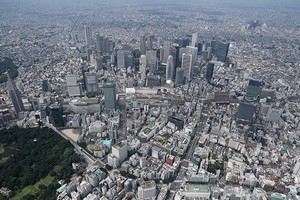THE ASAHI SHIMBUN
August 9, 2024 at 13:14 JST
The Japan Meteorological Agency issued its first megaquake advisory, covering 707 municipalities from Okinawa to Ibaraki prefectures, after a magnitude-7.1 earthquake struck off Miyazaki Prefecture on Aug. 8.
The 707 municipalities were designated in advance under the protocol for an expected monster quake emanating in the Nankai Trough in the Pacific Ocean. The trough has a history of huge earthquakes occurring in pairs.
Residents along the Pacific coast are urged to take caution for a possible megaquake over the next week, according to the JMA.
The Aug. 8 quake, which occurred at 4:42 p.m., registered a maximum intensity of lower 6 on the Japanese seismic scale of 7 in Nichinan, Miyazaki Prefecture.
The epicenter was around 30 kilometers off the coast in the Hyuganada sea at a depth of 30 km.
It occurred within the estimated epicenter area of a megaquake in the Nankai Trough, which stretches from the Tokai to Kyushu regions off the Pacific coast.
Conditions were met for the JMA to issue what is called the Nankai Trough Earthquake Extra Information.
A JMA panel meeting was convened, and the experts issued the megaquake advisory, the second highest alert, for the first time since the system was introduced in November 2017.
The JMA’s strongest megaquake warning calls for evacuations in advance.
“The possibility of a (Nankai Trough) earthquake occurring is now several times higher than usual,” Naoshi Hirata, professor emeritus at the University of Tokyo and chief of the JMA panel, said at a news conference. “We can’t tell exactly when or where a megaquake will occur, but we want people to reaffirm their preparedness.”
In Miyazaki Prefecture, intensities of upper 5 were recorded in Kushima and Miyakonojo cities on Aug. 8.
A tsunami advisory was issued for the Uwakai coast of Ehime Prefecture, Kochi Prefecture and the Bungo Channel coast of Oita Prefecture.
Tsunami waves of 50 centimeters hit Miyazaki Prefecture.
According to the Cabinet Office, 14 people were injured in Miyazaki, Kagoshima and Kumamoto prefectures due to falling objects.
Chief Cabinet Secretary Yoshimasa Hayashi said at a news conference on Aug. 8 that no abnormalities were detected at nuclear facilities, including the Sendai nuclear power plant in Satsumasendai, Kagoshima Prefecture.
In the past, huge earthquakes have occurred within short periods of each other along the Nankai Trough.
The magnitude-8.4 Showa Nankai Earthquake in 1946 struck two years after the magnitude 8.2 Showa Tonankai Earthquake hit in 1944.
In 1854, the magnitude-8.7 Ansei Nankai Earthquake occurred only about 32 hours after the magnitude-8.6 Ansei Tokai Earthquake.
Researchers say there is a possibility of 70 to 80 percent that an earthquake with a magnitude of 8 to 9 will occur in the Nankai Trough within the next 30 years.
The municipalities covered by the megaquake advisory can be seen from the QR code below, available only in Japanese.
(This article was written by Ryo Oyama and Shoko Rikimaru.)





















A peek through the music industry’s curtain at the producers who harnessed social media to help their idols go global.
A series based on diplomatic documents declassified by Japan’s Foreign Ministry
Here is a collection of first-hand accounts by “hibakusha” atomic bomb survivors.
Cooking experts, chefs and others involved in the field of food introduce their special recipes intertwined with their paths in life.
A series about Japanese-Americans and their memories of World War II